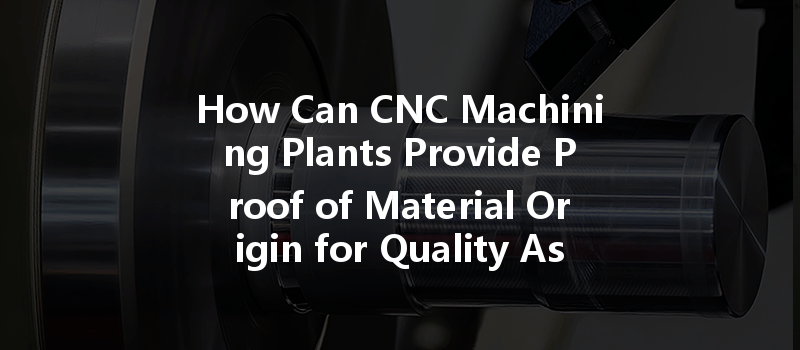Did you know that the global CNC machining market is projected to reach a staggering $100 billion by 2025? With advancements in technology and an increasing emphasis on quality assurance, CNC machining has become a pivotal industry in the manufacturing sector. However, as the demand for high-quality, reliable components grows, so does the need for transparency regarding the origin and certification of materials used in CNC machining processes. This raises a critical question: How can CNC machining plants provide proof of material origin for quality assurance?
In this blog, we will delve into the significance of material origin, the various strategies CNC machining plants can employ to ensure quality verification, and the impact these practices have on customer confidence, compliance with industry standards, and overall business success. We will offer practical solutions and insights, highlighting methodologies, technologies, and certifications that play a vital role in confirming the legitimacy of materials used in CNC machining.
Understanding the Need for Material Origin Proof
The Importance of Material Integrity
Material integrity is paramount in the CNC machining industry. Whether you are producing aerospace components, automotive parts, or medical devices, the quality of the raw materials directly influences the final product’s performance, safety, and durability. Therefore, establishing the provenance of materials is crucial for several reasons:
Key Regulatory Standards
A variety of regulatory standards exist that dictate the requirements for material traceability, including:
Challenges in Material Verification
While the need for proof of material origin is clear, there are significant challenges that CNC machining plants face:
Solutions for Providing Proof of Material Origin
Implementing Robust Supply Chain Management
CNC machining plants should conduct regular audits of suppliers to verify their compliance with material specifications and industry standards. Certifications such as ISO, ASTM, and others should be actively pursued, ensuring that suppliers follow established best practices.
An essential aspect of material verification involves obtaining Material Test Reports from suppliers. MTRs provide comprehensive details about the material’s properties, including chemical composition, mechanical properties, and testing results, thereby ensuring quality.
Adopting digital supply chain management platforms can streamline the process of tracking material origins. These platforms can automate documentation and record-keeping, allowing for easy verification and audit readiness.

Leveraging Technology for Traceability
Blockchain technology offers a secure and transparent method for tracking material origins. By creating immutable records of each material’s journey through the supply chain, CNC machining plants can enhance traceability and provide credible proof of origin.
Implementing IoT sensors can facilitate real-time monitoring of material usage and inventory levels. These devices can track and record each material’s data, contributing to comprehensive documentation of its origin.
Radio Frequency Identification (RFID) tags can be used to track materials throughout the machining process. By scanning these tags, manufacturers can access information regarding the material’s source, processing history, and compliance status.
Establishing Capacity for Quality Documentation
A well-implemented QMS can help CNC machining plants maintain rigorous standards for material verification. Documentation protocols within the QMS should mandate that all materials received are accompanied by relevant documentation confirming their origin.
Continuous training and education programs for employees about the importance of material traceability can promote a culture of quality assurance within CNC machining plants. Employees should be well-acquainted with compliance standards and best practices for verifying materials.
Collaboration with Industry Bodies
Collaborating with industry organizations can provide CNC machining companies with valuable resources and insights regarding best practices for material verification. These collaborations can lead to improved standards and shared knowledge among peers.
Involving customers in the verification process by providing access to material certification documentation can enhance transparency and foster trust. Encouraging feedback on material quality can also help refine sourcing strategies.
The Benefits of Providing Proof of Material Origin
The benefits of successfully providing proof of material origin are many and impactful:
In an increasingly competitive landscape, CNC machining plants must prioritize the verification of material origins as a foundational element of their operations. By implementing robust supply chain management strategies, leveraging technology for traceability, and establishing comprehensive quality documentation practices, manufacturers can ensure compliance, enhance product quality, and bolster customer confidence.
Ultimately, the quality of a finished part hinges on the integrity of its constituent materials. The practices outlined in this blog— from engaging in supplier audits to adopting cutting-edge technology— serve not just as a pathway to compliance, but as a commitment to excellence. As the CNC machining industry continues to evolve, understanding and providing proof of material origin will remain an essential consideration that manufacturers must address. This approach is not only key to meeting industry standards but also serves as a competitive advantage in today’s discerning market.
Therefore, as we move forward in this fast-paced and demanding industry, we must remember that transparency in sourcing and material verification is not just a regulatory obligation— it is an invitation to cultivate trust, produce superior products, and leave a lasting mark in the bustling world of CNC machining.






